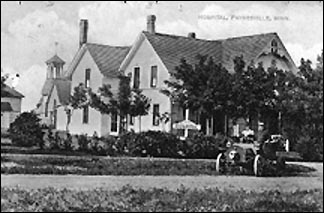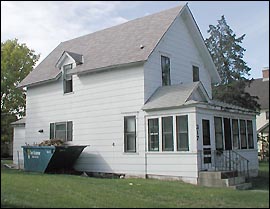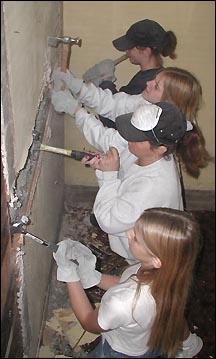Mishap uncovers basement of town's first hospital
 A truck delivering a dumpster rediscovered part of Paynesville's past last week. Nearly fell into it, to be more exact.
A truck delivering a dumpster rediscovered part of Paynesville's past last week. Nearly fell into it, to be more exact.A dumpster was needed to collect the rubble from an extensive interior remodeling at a 100-year-old house on Hoffman Street (Highway 23). A wheel of the truck delivering the dumpster fell through a concrete pad and uncovered part of the foundation of Paynesville's first hospital. See picture at left.
Dr. P. C. Pilon, a French-Canadian born in Ontario, started a medical practice in Cold Spring in 1887 and moved to Paynesville ten years later after a fishing trip to Lake Koronis, according to information from the Paynesville Area Museum. He studied surgery in Europe in 1897 and purchased a home in Paynesville a year later.
At first he treated patients in his home, which still stands on the corner of Hudson and Hoffman streets. But in the summer of 1898 he purchased a neighboring house, expanded it and remodeled it into a hospital, and opened it in the fall of 1898, according to museum records.
This is considered to be his first hospital and the first in Paynesville, which was founded in 1857.
 Bonnie Mattson purchased the house a couple weeks ago and started an extensive interior remodeling project: ripping out walls, adding insulation, and planning to redo the interior of the house.
Bonnie Mattson purchased the house a couple weeks ago and started an extensive interior remodeling project: ripping out walls, adding insulation, and planning to redo the interior of the house.
At right, the house when it was Dr. Pilon's hospital. At left and below, as the house appears today.
She is being helped in her remodeling project by friends and her daughters: Megan Jolly, a sophomore at PAHS, and Crystal Jolly, a seventh grader at PAMS. They needed a dumpster to get rid of the rubble created from their demolition of the interior of the house.
 Mattson knew that the house had at one time been a hospital, and she even heard a rumor that a tunnel used to connect the house to a neighbors' home. She had been told that the tunnel had been filled in and that the concrete was just on the top.
Mattson knew that the house had at one time been a hospital, and she even heard a rumor that a tunnel used to connect the house to a neighbors' home. She had been told that the tunnel had been filled in and that the concrete was just on the top.
She had no idea that there was a hollow space underneath the concrete slab. That there was a basement room in the yard.
After the truck's mishap rediscovered the room, Mattson found an entrance to it behind a curtain in the basement. "I thought the blanket was just hanging on the wall," she said. "I had no idea that it was open."
The old basement room is piled a couple feet high with old paint cans, dirt, old doors, etc. The remnant of the chimney is still standing in a corner, and two entryways - either doors or windows - are still evident.
 The room appears to be the foundation of a wing of the Pilon hospital, thought Mattson, after examining a museum picture of the hospital as it used to look. "No wonder it's starting to crumble," she said. "If I was 100 years old, I'd start to crumble, too."
The room appears to be the foundation of a wing of the Pilon hospital, thought Mattson, after examining a museum picture of the hospital as it used to look. "No wonder it's starting to crumble," she said. "If I was 100 years old, I'd start to crumble, too."
Bonnie Mattson (second from bottom) is working to remodel the first Pilon Hospital with help from her girls, Crystal Jolly (bottom) and Megan Jolly (second from top), and a friend Jennifer Lipinski (top).
Mattson plans to remodel the upstairs of the house first so she and her family can move in. The discovery of the basement room adds another cost to her remodeling project. She needs to get the foundation in the basement shored up a bit before the approximately 12' by 15' room can be filled. "Save a penny here; spend two thousand there," she said of the extra costs that unforeseen events can cause in remodeling projects.
Dr. Pilon - who devoted his practice to surgery and earned a great reputation - performed over 6,000 surgeries in the hospital from 1898 to 1914. He eventually built a large four-story hospital on the corner of Washburne Avenue and Highway 23. "I know it was the first hospital and Dr. Pilon built it," said Bertha Zniewski, the curator at the Paynesville Area Museum. "Then he built another hospital where the Good Samaritan Care Center is now and sold these houses."
The house today is smaller than it was as Pilon's hospital. Evidently, over the years, the wings to the east either were taken down or collapsed.
Pat Jones of Paynesville Excavating thinks that the basement room was large enough and cool enough to have served as the hospital's morgue.
Dr. Pilon served in the United States Army in World War I and was in charge of a 1,400-bed hospital in France. He operated a hospital in Paynesville until 1945, when he retired.
Contact the author at paypress@lkdllink.net • Return to News Menu
Home | Marketplace | Community